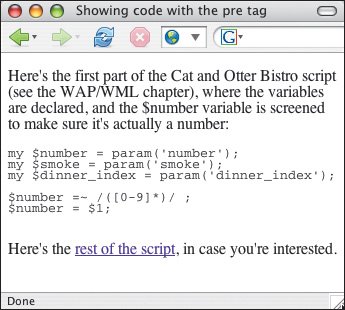Using Preformatted Text
| Usually, browsers collapse all extra returns and spaces and automatically break lines according to the size of the window. Preformatted text lets you maintain the original line breaks and spacing that you've inserted in the text. It is ideal for computer code examples. To use preformatted text:
Figure 4.9. The pre element is ideal for text that contains important spaces and line breaks, like the chunk of Perl CGI code shown above. Figure 4.10. Notice how the line breaks, including the extra return between the third and fourth lines of code, are maintained.
|
EAN: 2147483647
Pages: 340


 Tips
Tips